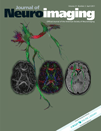Intraplaque Hemorrhage in Symptomatic Intracranial Atherosclerotic Disease
J Neuroimaging 2011;21:e159-e161.
Abstract
ABSTRACT
BACKGROUND AND PURPOSE
Studies in patients with extracranial carotid disease have shown that high-resolution magnetic resonance direct thrombus imaging (MRDTI) can reliably identify intraplaque hemorrhage, which may be a better predictor of clinical events than traditional radiographic methods such as percent stenosis. We present the use of high-resolution magnetic resonance imaging for the detection of intraplaque hemorrhage in the intracranial arteries.
METHODS
High-resolution 3 Tesla MRDTI was performed using T1-weighted scans with an inversion pulse to null the signal from blood. Abnormal intraplaque T1 signal compatible with hemorrhage or blood products was defined as equal to or higher than 150% of T1 signal of adjacent muscle.
RESULTS
The symptomatic middle cerebral artery demonstrated intraplaque signal higher than 150% of the muscle signal in two central slices, consistent with the imaging characteristics of intraplaque hemorrhage demonstrated in extracranial carotid arteries.
CONCLUSIONS
High-resolution MRDTI of intracranial atherosclerotic lesions could provide a surrogate marker of plaque activity in vivo and could lead to improvements in risk stratification and treatment of this common disease.




